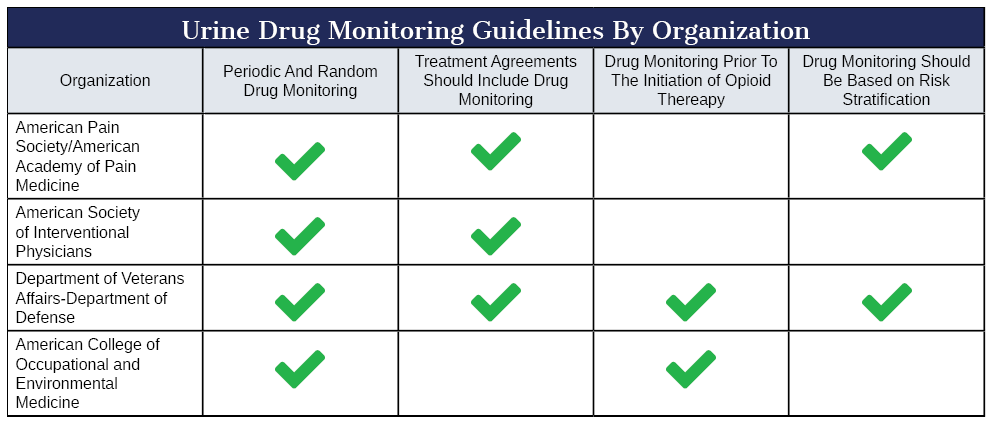Comparing Drug Testing Protocols – A Case Study

The Importance of Establishing Consistent Protocol
One of the most popular topics our specialists are questioned on is best practices in drug testing/medication monitoring protocols. It is very common for testing protocol to vary significantly from clinic to clinic or among different treatment programs. In order for practices to establish effective monitoring programs, their protocol must be consistent and it must be executed consistently among all providers within the practice. For example, inconsistent results will manifest in a practice in which one provider adheres to tight protocol while other providers only screen if the patient “looks high” or seems to be exhibiting red-flag behavior.
Erratic protocols can not only create discord among staff, but because patients talk to each other, inconsistencies can also jeopardize the patient-physician relationship. Conducting ongoing substance abuse screening as part of treatment can also reduce the likelihood patients will divert their medication. If a patient isn’t using their prescribed medication, it’s likely they are selling it. Since medication diversion endangers the whole program, it’s essential to test and assess compliance. Consistent screening can also benefit the patient by giving them accountability. Studies have shown that patients held accountable through effective drug screening protocols are less likely to relapse.
The following table outlines how select organizations advise on testing protocol guidelines specific to drug monitoring. The guidelines suggest periodic and random drug monitoring to be of critical importance. Additionally, the consensus panel that developed the Clinical Guidelines for the use of Buprenorphine in the Treatment of Opioid Addiction recommends that physicians periodically screen all patients for substance use and substance-related problems not just those patients who fall into the stereotypical picture of abuse. Requiring patients to sign contractual treatment agreements at the time of initial intake helps to inform patients of the established drug monitoring protocol prior to receiving treatment. The guidelines also suggest stratifying patients according to risk, with high risk patients being monitored more frequently. Through experience and many case studies, it is evident that consistency is best regardless of the differing established organizational guidelines.
Baseline Testing
The use of baseline testing is critical to identifying any predisposition in patients in which we may see other controlled substances or illicits. Additionally, it is suggested that patient red-flag behavior such as calling in early for a refill, requesting specific drugs, reluctance to grant permission to obtain past medical records, or attempting to fill prescriptions at multiple pharmacies warrants additional testing. The American Society of Interventional Pain Physicians (ASIPP) states in their evidence assessment that one-third of chronic pain patients may not use prescribed opioids as prescribed or may abuse them, and illicit drug use is known to be significantly higher in these patients.
In terms of patients that are in treatment specifically for opioid dependence, such as buprenorphine or methadone treatment programs, these patients have already established that they are high risk and may be tested more frequently. Any patient prescribed an opioid, stimulant or benzodiazepine should be tested upon initiation of narcotic or controlled substance treatment to establish a baseline for later comparison. Essentially, testing is performed for any patient in which their prescription has potential for abuse, misuse or diversion. The following case study conducted by Premier Biotech Labs, showcases the apparent differences in clinical drug testing protocol by directly comparing the practice guidelines of two separate clinics.
Premier Biotech, A Trusted Partner for Success
Establishing a consistent drug testing/medication monitoring protocol is a critical component to protecting the patient, practice and the community. If a practice is not testing accordingly, they run the risk of missing critical information that would certainly change clinical decisions and impact treatment outcomes. Premier Biotech has extensive experience assisting clinical-solutions clinics and treatment providers with monitoring prescriptions, medication adherence and compliance, preventing dangerous drug interactions, and helping to establish successful drug testing protocols.

